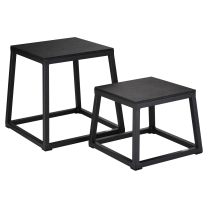Best Leg Exercises Using A Plyo Jump Box
Best Leg Exercises Using A Plyo Jump Box

One of the best ways to build strength and improve your functional fitness levels is by doing bodyweight exercises.
The only thing is, these types of exercises – known as callisthenics – can often be one of two things:
• Too hard – L-sits, planche push ups and muscle ups are all some of the most difficult exercises you can do and can take a long time to master.
• Not hard enough – it can be difficult to build muscle when you’re limited to air squats, planks and step ups.
So, finding the middle ground can be tricky.
Plyo jump boxes are extremely versatile and are one of the best tools to build strength while just using your bodyweight.
And they’re not just for jumping on either. They can be used for a full range of upper and lower body strengthening exercises, as well as for cardio.
What is plyometric training?

Plyometric training refers to explosive-style exercises which are designed to help you increase speed and power.
They involve exerting a large amount of force onto your muscles, within a short amount of time and can include anything from jumping squats to jumping push ups.
They’re more about conditioning as opposed to building muscle. However, doing this style of exercise is going to help supplement your heavy lifts and is really important for your overall fitness levels.
Doing plyometric exercises also helps to condition your nervous system, improves endurance levels and they’ll also get your heart rate really high.
What are the different types of plyo jump box
There are several different types of plyo jump box
• Soft plyo jump boxes - these are made from high density foam which is hard enough to jump up on but soft enough to absorb the impact of your jumps. They’re also a lot more forgiving should you fail the jump and land on your shins. There’s the 3in1 Soft Plyo Box option which can be turned onto its sides to create different height levels. Or you can get a stackable set which is ideal for anyone looking to jump high or simply use a wide range of heights for a variety of exercises.
• Wooden plyo jump boxes - wooden plyo jump boxes are more sturdy than soft plyo boxes. They are, however, usually more suited to those who are already experienced in using plyo jump boxes as they can hurt if you miss! They also don’t stack but you can get sets just as easily which allows you to take advantage of having multiple boxes to train with.
• Steel plyo jump boxes - these are great for training at home as they take up next to no room and will give you a really challenging workout. You can buy them individually or as a set. Like the wooden plyo boxes, they provide a really firm platform to jump up onto and they have a rubber top to prevent slipping.
How to do a box jump
Doing box jumps is a great way to build strength and endurance as well as improve your explosivity.
But if you’re new to plyometric training, it’s only natural to feel a bit unsure as to how to get started.
Start by warming up and doing some dynamic stretches to make sure that you don’t injure yourself. Get more information on best warm up exercises to do here.
• Find a Plyo Jump Box that’s a good height to get started with – nothing too high. A box that’s around 20” high is perfect for anyone new to plyometrics.
• Next, you want to concentrate on engaging your larger muscle groups to ensure you get as much push as possible. Squat down until you feel your glutes and hamstrings working.
• Swing your arms back and tighten your core as you bring your arms, knees and feet up all in one motion.
• Land in a deep squat position with your feet slightly turned out. Make sure your knees are bent to help soften the landing.
• Stand up straight while using your glutes and hamstrings to push you up – just like you would do when doing a squat. Your core should still be engaged.
• Finally, jump back down and land with your knees bent to help absorb the impact.
Which muscles do box jumps work?

Box jumps are compound exercises which means they work several muscle groups at the same time.
They work your -
• Hamstrings
• Quads
• Glutes
• Calves
• Core
• Hip flexors
And if you’re using your arms a lot to get up onto the box, you’ll also be using your biceps, triceps and delts. However, these are secondary muscles so you’re not working them as much as the muscles in your lower body.
When doing box jumps, it’s important to include some single leg plyometric training as well. This is because box jumps won’t help you work on any imbalances you have.
For example, many people have one side that’s stronger than the other.
So, by working on one side at a time, you can keep an eye on your weaker muscles and make sure that the stronger side isn’t carrying you through the exercise.
Plyo boxes can be used for a wide range of single leg exercises including single leg box jumps, as well as step ups, single leg squats and side step ups – all of which you can include in your workout.
Jump box workout
To help you get the most out of your training, here’s Danielle from MSP Fitness with her workout using our 3in1 Soft Plyo Jump Box.
The exercises
• Box jumps
• Tricep dips
• Burpee step ups
• Decline press ups
• Single leg lunge
Do each exercise for one minute with a 10-second rest in-between each exercise.
Repeat the circuit 2-3 times if you’re just starting out. Or, if you’re more advanced, you can do it 4-5 times, for a more intense workout.
For more content, follow us on Instagram, YouTube, TikTok, and on our official Mirafit Facebook page.
Enter your email to signup to our newsletter
Tags: Equipment > Plyo Jump Box ; Exercise Type > Cardio ; Misc > Workout ; Target Area > Legs









